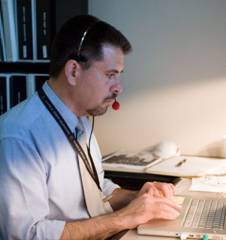Abstract:
Hubble Space Telescope Servicing Mission Four (HST SM4) Unique Safety Challenges for STS-125
The Hubble Space Telescope (HST) has nominally been serviced every three years; but seven years have now passed since the last servicing mission. The current mission (SM4) is much broader in scope than any before, demanding a much higher degree of safety participation in hardware design and mission operations. Unprecedented hardware installation includes batteries, a new science instrument computer and a Soft Capture Mechanism (a structure enabling the future safe de-orbit of HST). The mission includes challenging extra-vehicular activities (EVAs) to restore two instruments never designed for on-orbit repair. Following a successful five EVA day mission, a restored HST should return science well into the next decade and enable a safe de-orbit at the end of observatory life.
HST Servicing Mission 4 (SM4) was originally scheduled to launch in October of 2008. However an on-orbit failure inside the Science Instrument Control and Data Handling (SI C&DH) unit caused a slip into 2009. This event is one of a number that have made mission success and safety engineering problematic for the flight on STS-125. As more hardware elements and EVA tasks have been added, operational assumptions and engineering have been revisited leading to both a more effective and safer mission design. New instruments and guidance sensor replacement have been performed before. However in-situ replacement of circuit boards, planned for this mission, has never before been accomplished on-orbit. Along with SI C&DH replacement, emplacement of a Soft Capture Mechanism (for future HST de-orbit), replacement of aging batteries, and repair of on-orbit instruments led to new processes and tools. The new tools and techniques required careful safety assessments, documentation and acceptance to insure a successful mission.
Biography:

 Robert Dedalis
has worked for NASA since 1985. He has a Bachelor of Science in Chemical Engineering, and a Masters in Engineering Management. He works for the System Safety Branch, in the Office of Safety Mission and Assurance, at Goddard Space Flight Center, in Greenbelt, Maryland.
Robert Dedalis
has worked for NASA since 1985. He has a Bachelor of Science in Chemical Engineering, and a Masters in Engineering Management. He works for the System Safety Branch, in the Office of Safety Mission and Assurance, at Goddard Space Flight Center, in Greenbelt, Maryland.
Bob supported the Upper Atmospheric Research Satellite flight on STS-48. He obtained range safety approvals for the flight of the Small Explorers on the Pegasus launch vehicle in the mid 1990s. Bob has also worked a number of other satellites launched on the Delta and Atlas expendable launch vehicles.
Bob has been the Safety Manager for The Hubble Space Telescope Flight Development Project at NASA since 1998. He was responsible for the flight and ground safety program for HST Servicing Mission 3A and 3B, as well as SM4 this past May. During these flights, he worked as part of the HST Systems Management team, which supported servicing mission operations at Mission Control in Houston.

 Robert Dedalis
has worked for NASA since 1985. He has a Bachelor of Science in Chemical Engineering, and a Masters in Engineering Management. He works for the System Safety Branch, in the Office of Safety Mission and Assurance, at Goddard Space Flight Center, in Greenbelt, Maryland.
Robert Dedalis
has worked for NASA since 1985. He has a Bachelor of Science in Chemical Engineering, and a Masters in Engineering Management. He works for the System Safety Branch, in the Office of Safety Mission and Assurance, at Goddard Space Flight Center, in Greenbelt, Maryland.